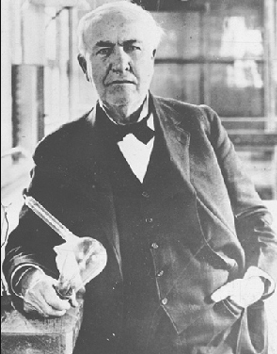
In 1876 Thomas Edison established the the world’s first industrial research facility in Menlo Park New Jersey. Edison holds over 1,000 United States patents, and numerous foreign patents, but his greatest invention, predating Silicon Valley by almost 100 years, is the industrial research facility.
The Menlo Park facility was funded by Edison’s 1874 invention of a telegraph which could simultaneously send 4 separate telegraph signals over the same wire. The Western Union telegraph company paid Edison $10,000 for the rights to his patent – at a time when $15 a week was an excellent salary.
But it was the invention of the phonograph in 1877 which brought Edison wide-spread fame.
Edison’s approach to inventing was represented in Edison’s approach to the telephone. Edison took a discovery made when experimenting with and underwater cable for telgraphy, and applied the results to a problem that existed with the telephone and which it would profitable to solve.
Edison’s discovery when working on underwater telegraphy cable was that the electrical resistance and conductivity of carbon varied with pressure. In February of 1877 Edison began experiments to produce a “pressure relay” using carbon that would vary and balance the electric currents used by the telephone, and amplify them to improve audibility in a manner superior to the magnets then in use. By the end of 1877 Edision had developed the immensely useful, durable, and profitable ‘carbon transmitter’ microphone which continued to be utilized in telephones until the 1980’s, and still in use in some low-end microphones and telephones.
The successful ‘carbon transmitter’ was then turned in a new direction, by coupling it with theories of other researchers, primarily the French inventor Leon Scott, who had postulated that sounds, if they could be graphically recorded, would produce distinct shapes – phonography (or, literally “sound writing”). Edison rigged a stylus-tipped ‘carbon transmitter’ amplifying microphone to make impression on a cylinder wrapped in a thin layer of tin. The minor and barely visible ridges in the cylinder, played back under the stylus, reproduced the sound. It was this invention which – the “phonograph” which ultimately brought Edison, who came to be dubbed the “Wizard of Menlo Park”, his first truly widespread public fame.
There is a general belief that Edison invented the incandescent electric light bulb. In fact, what Edison did was, through educated and tenacious trial-and-error experimentation at his Menlo Park facility, develop a system including a high resistance bulb with a long-lasting and inexpensive filament – solving the problems which had prevented others from using electricity as a source of illumination. Ultimately, the key was the long-lasting inexpensive filament (the term itself selected by Edison) which would burn for several hundred hours. Edison utilized a carbonized fiber suspended in a vacuum.
Edison was not interested in the ‘pure’ research like a unversity research lab, nor in simply tinkering like a machine shop to improve current art. Rather, he was interested in systematically investigating and improving on prior art in a way that would be produce profitable utility. He employed both the theories and discoveries of others, worked long hours himself, drove his staff hard, and had the fruits of their labor – the patents – registered in his own name.
Edison’s system of “direct current” power generation and distribution, and his battle with the system of “alternating current” developed by Nikola Tesla, further represented Edison’s approach both to invention and commercial exploitation. Tesla’s system was superior to the Edison system for the puposes for which Edison was promoting his ‘direct current’ transmission systems. Tesla’s alternating current could be transformed to very high voltages, sent over less expensive (thinner) wires, and transformed down again at the receiving end for distribution to customers.
But it was Edison’s system which came to be widely adopted, and Edison utilized every means at his disposable to ensure this was the case. When the problems of Edison’s direct current system, and the superiority of Tesla’s system of alternating current became apparent on a widespread public basis, Edison employed propaganda to end the debate, going so far as to campaign to have alternating current banned on the basis that it was too dangerous. An opponent of the death penalty, Edison nevertheless contributed to the development of the electric chair, which utilized Tesla ‘alternating current’ to demonstrate the lethality of alternating current.

